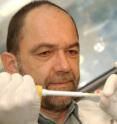DNA fingerprinting pioneer discovers role of key genetic catalyst for human diversity
One of the key drivers of human evolution and diversity, accounting for changes that occur between different generations of people, is explained by new research published today (Sept 5) by world-renowned scientist Professor Sir Alec Jeffreys, who discovered DNA fingerprinting at the University of Leicester. Professor Jeffreys has spent over two decades since his landmark discovery in 1984 investigating what he describes as "pretty bizarre bits of DNA" - highly variable repeated parts of DNA called 'minisatellites' - found in the human genome. Sir Alec observed that these seemed to be changing and "picking up mutations at an extraordinary rate" when compared to other DNA.
Now, in a paper published online in Nature Genetics (Sept 5), Sir Alec and his team in the Department of Genetics at the University of Leicester have demonstrated the remarkable influence of a particular gene on the development of diversity in humans.
The work was funded by the Medical Research Council, the Wellcome Trust, the Boehringer Ingelheim Fonds, the Royal Society and the Louis-Jeantet Foundation. Professor Jeffreys is Royal Society Wolfson Research Professor of Genetics at Leicester.
Sir Alec said: "In each generation our genetic make-up gets 'reshuffled', like a genetic pack of cards, by a process called recombination - a fundamental engine driving diversity. The work we have done over the past 10 years at Leicester has been key to understanding recombination in humans, and has allowed the molecular definition of recombination 'hotspots' - small regions in which the reshuffling process is focused.
"Our new study has focused on a gene called PRDM9 that makes a protein which binds to DNA and triggers hotspot activity. The exciting finding is that people with different versions of PRDM9 show profoundly different recombination behaviours, not only in hotspots but also in chromosomal rearrangements that cause some genetic disorders."
Ironically, the variation in PRDM9 is due to a minisatellite within the gene itself. Sir Alec said: 'I've come full circle – starting out with minisatellites to develop DNA fingerprinting, and arriving at a gene containing a minisatellite that plays a key role in driving all kinds of human DNA diversity, including variation at minisatellites. An intriguing possibility is that it is even driving its own evolution!'
Sir Alec believes the research, along with that of others working in the field, will inevitably further scientists' ability to understand the basic processes that make us all genetically unique, as well as defining an entirely new class of genetic risk factor for numerous disease-causing DNA rearrangements that can arise when recombination goes wrong.
These findings also provide a neat solution to one great puzzle of recombination hotspots – namely that they appear and disappear rapidly during evolution. Sir Alec said 'We've shown that hotspots have a strange propensity for self-destruction, so how can they possibly exist? The PRDM9 minisatellite gives the answer – it evolves rapidly, like any other unstable minisatellite, and keeps churning out variants that can trigger new hotspots, replenishing those that have committed suicide. A totally crazy mechanism to ensure that recombination keeps going, but typical of the weird solutions that evolution can throw up'.


